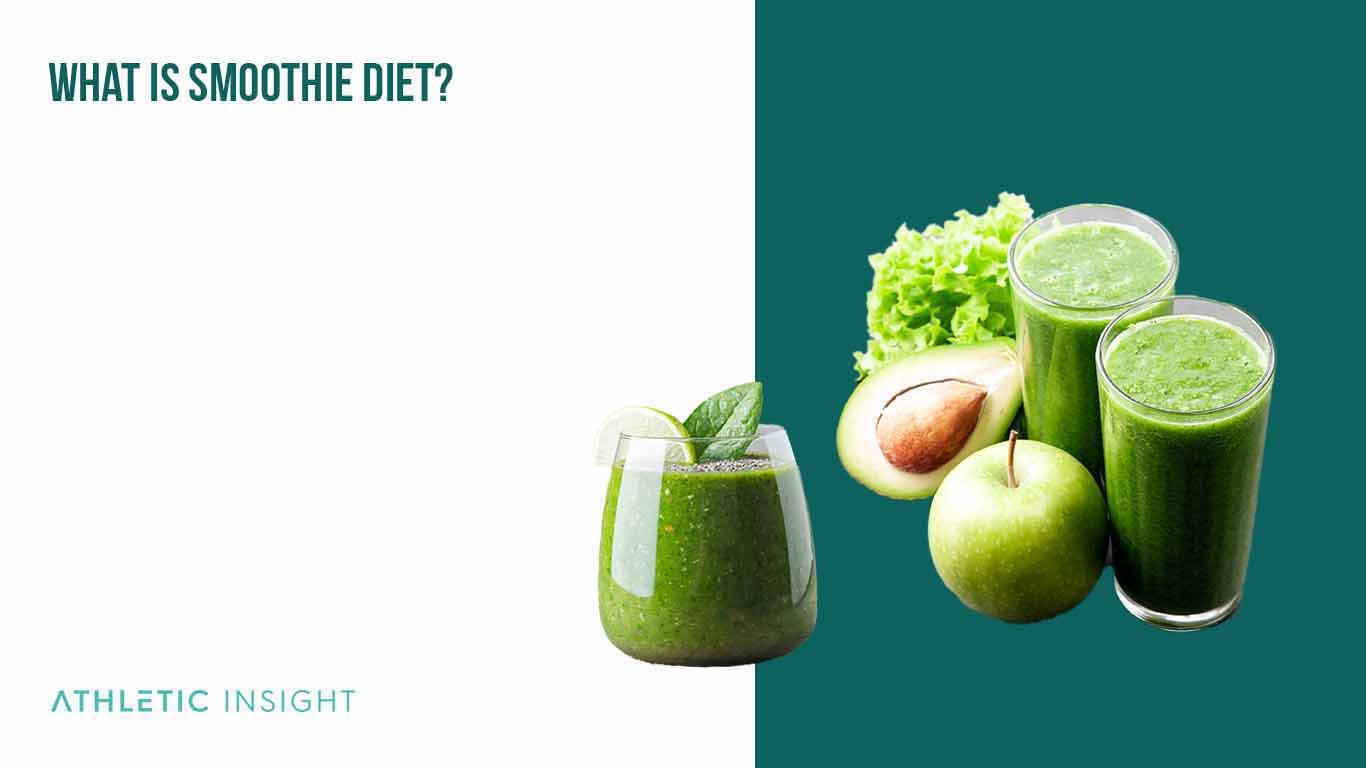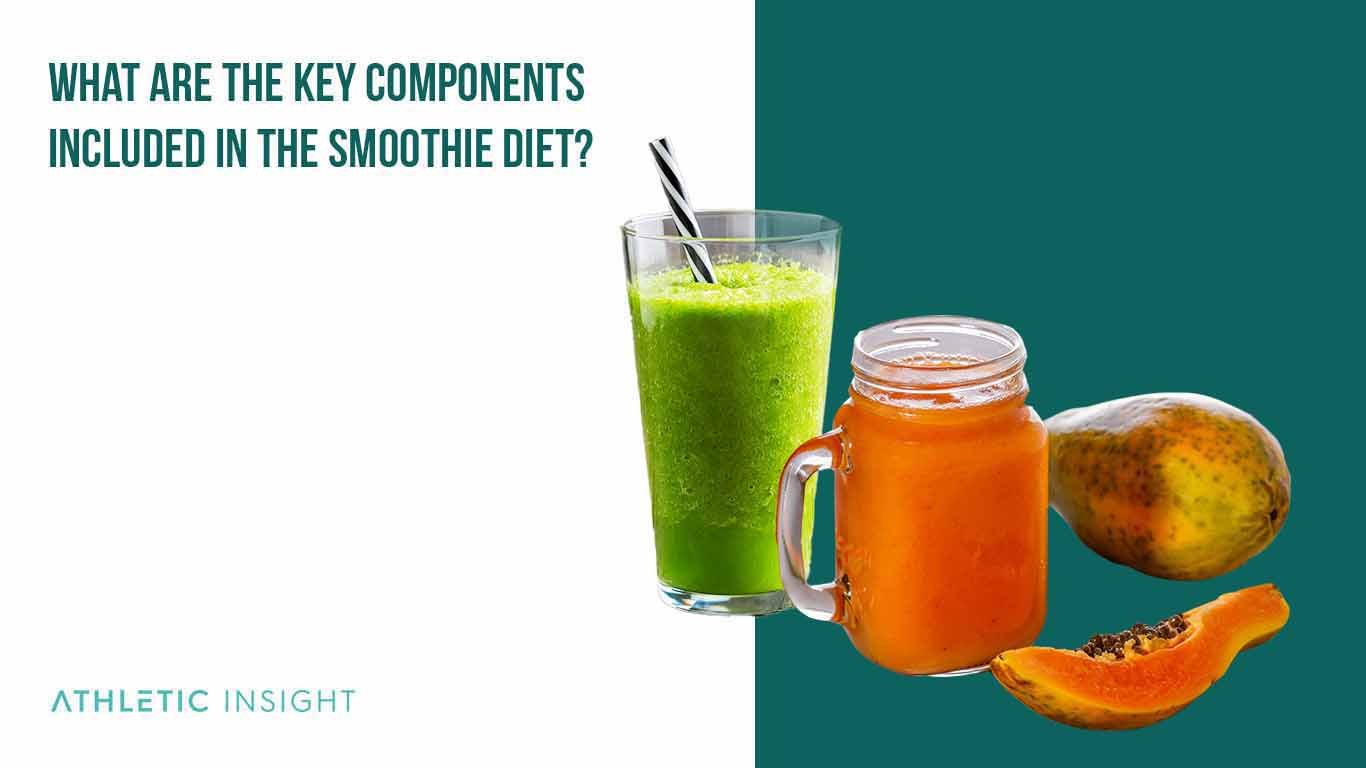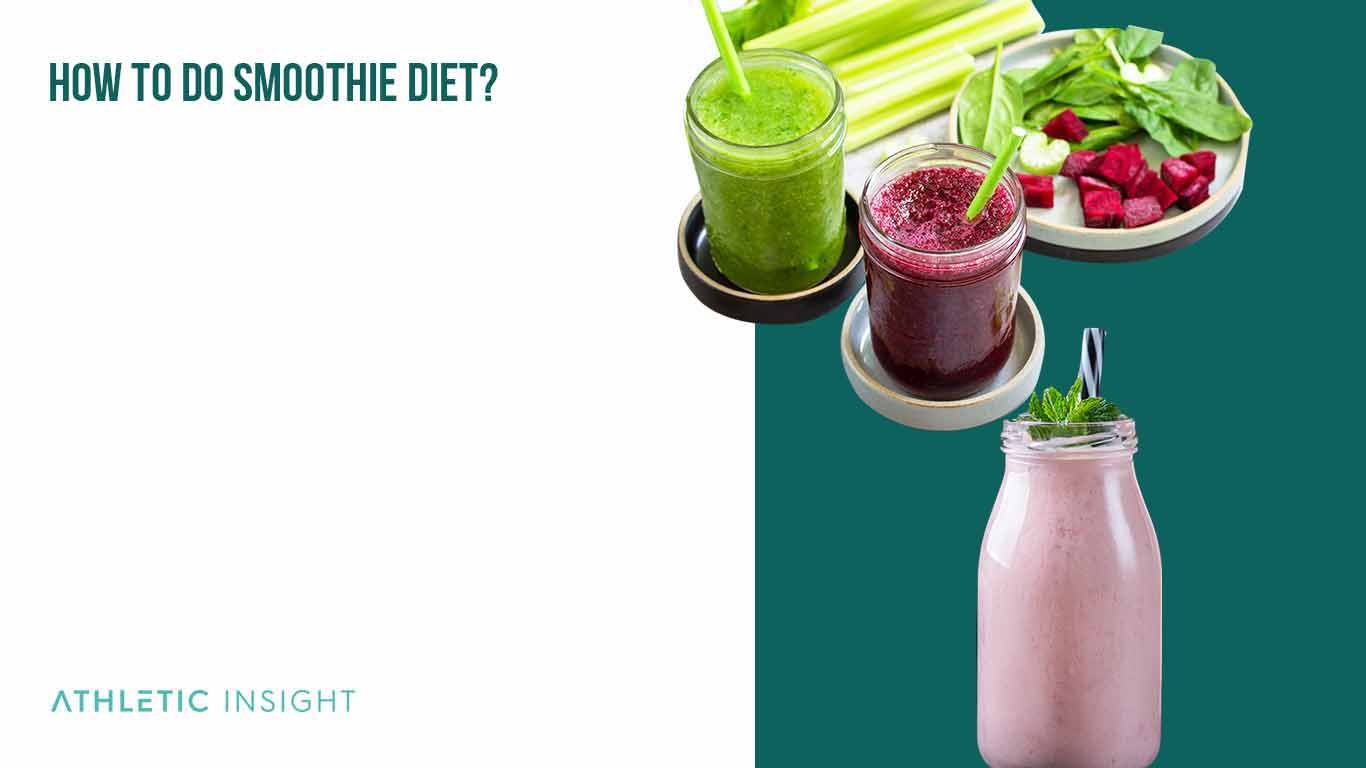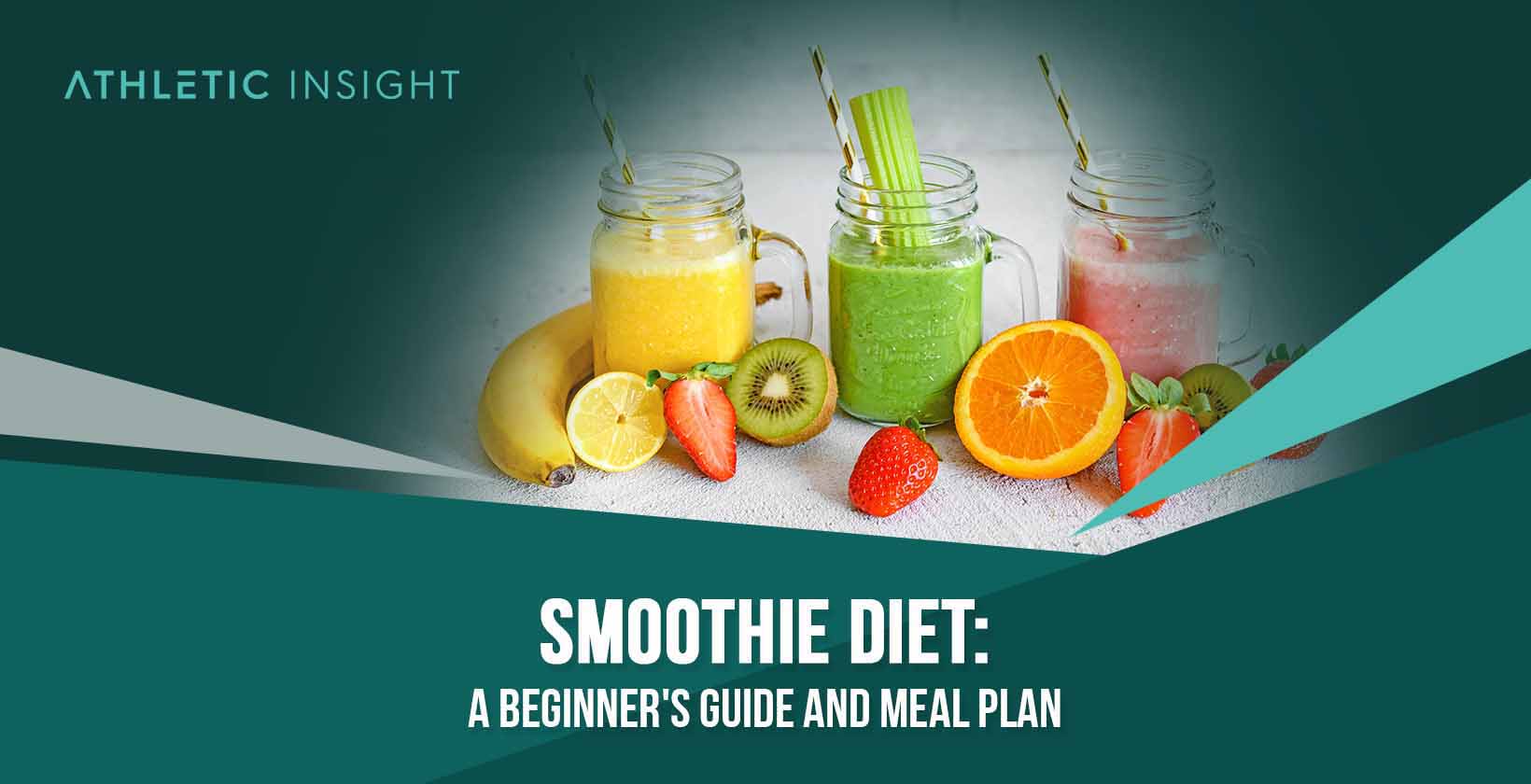The smoothie diet is a meal plan that involves all or most of a person’s daily calories from smoothies consisting of fruit, vegetables, milk/liquid, and other supplements. A smoothie diet consists of eating smoothies (liquids and juices) made from fruits and vegetables. People can also add a protein powder, supplement, or milk to their smoothies for flavor.
The importance of the smoothie diet is to help a person who needs to lose weight quickly. If you have high levels of body fat or a high BMI, a short-term smoothie diet can help you lose weight quickly due to the calorie reduction and liquid-only diet.
The benefits of a smoothie diet are less of a focus on food, less money spent on grocery shopping, easy meal preparation, consuming whole foods, and avoiding sugary and processed snacks.
A person can start a smoothie diet by cutting out unhealthy foods and snacks and replacing a meal with a smoothie made from vegetables and fruits. For those who need a more immediate solution to chronic disease or a very high BMI, switching to a smoothie-only diet or an all-liquid diet can help.
Eventually, you can switch to an all-smoothie diet for a short period or a long-term smoothie diet that still incorporates 1-2 meals per day of whole food. Some examples of whole food to incorporate include lean protein, complex grains, and cooked vegetables.
The most popular smoothie diet types include the 3-day cleanse, 7-day smoothie diet, 21-day smoothie diet, and 30-day smoothie diet. The main differences in these smoothie diet variations include the time and the solid food allowed during the meal plan.
For example, some smoothie diets allow people to eat one or two nutritious meals per day. The smoothie is meant to replace a third meal, which can help increase vitamin intake, boost mineral consumption, and reduce overall calories consumed.
In other types of the smoothie diet, people consume most of their calories from smoothies or juices and rarely eat solid food. This is a more drastic option for those who need to lose weight, lower blood pressure, or reduce blood sugar levels.
What is a Smoothie Diet?
A smoothie diet is either an all-liquid or mostly-liquid diet that includes fruits and vegetables. A person can do a short-term all-liquid diet to lose weight, improve clarity, boost skin and nail health, and drop fat quickly, or do a long-term smoothie diet that includes whole-food snacks or foods (such as hummus, raw nuts, seeds, soups, nut butters, and grains).

The specifics of the smoothie diet will differ based on the plan followed. Some smoothie diets only allow for liquid consumption and no solid foods, whereas others allow for whole-food snacks and meals. Some smoothie diet types replace 1-2 meals per day with a smoothie. In this case, the third meal can be a whole-food meal consisting mainly of organic meat, vegetables, fruits, and whole grains.
The main food groups in the smoothie diet are fresh fruits and vegetables. Many people following this diet plan will supplement their liquid intake with protein powders or non-dairy milk to add substance, calories, and protein to their smoothies.
Including protein powder, supplements, and/or non-dairy milk is a good way for those on a smoothie diet to get enough protein to avoid losing muscle mass, make up for any lost nutrients found in other foods, and satiate a craving for sweet foods.
How does Smoothie Diet Work?
The smoothie diet works by reducing a person’s consumption of unhealthy food. A person can avoid reliance on snacking, eating sugary foods, or eating sweets by partaking in a smoothie diet to lessen their psychological dependence on solid food.
Anyone can begin a smoothie diet by looking up healthy recipes and replacing one meal daily with a smoothie. After a few days, you can replace another meal with a smoothie to slowly work towards an all-smoothie diet.
The proposed time frame for a smoothie diet is either 7, 10, 21, or 30 days. People who need to lose an extreme amount of weight, like obese individuals, can consider doing a 21-day or 30-day cleanse. Those who need to clean out their system, improve digestion, or simply want to eat healthier can go for a shorter time frame.
The initial reaction to a smoothie diet is a drop in energy. However, this will soon change. Once you get used to the lack of solid food or less sugar in your diet, you will experience a boost in mental clarity, a less “full” feeling, more energy, and a brighter skin complexion.
Lastly, a person doing the smoothie diet will be able to re-work their digestive system and affect how their pancreas absorbs insulin. The pancreas is in charge of your blood sugar levels. Reducing the amount of sugar intake in your diet can help your pancreas function at an optimal level.
What are the Key Components included in the Smoothie Diet?
The key components in the smoothie diet are paying attention to sugar (carbs), fats and protein.

- DO pay attention to sugar: Ample fruit in your smoothie can lead to high sugar levels. Ensure you have a good balance of vegetables and fruits in your smoothie.
- DO add more Protein: Smoothies are low in Protein, so it is difficult to feel full for a long time or keep on your muscle mass. Add Protein to ensure you don’t lose weight in the wrong places.
- Do NOT avoid fat: Fat is a great way to keep yourself full and charge your body from burning carbs to burning fat. Add healthy fats to your smoothie, such as flaxseed oil, to stay full and reduce hunger.
- Do NOT have sugary drinks: Consuming alcohol, coffee, tea, and soda can cause your smoothie diet to backfire due to rising cortisol levels.
What are the health benefits of a Smoothie Diet?
There are numerous benefits of the smoothie diet such as having more energy, improved digestion, reducing bloat, reducing inflammation, reduced craving for sweets, improved vitamin and mineral levels, and better skin complexion.
- More energy: By reducing sugar intake and changing your energy absorption from heavy carbohydrates to healthy fats and protein, you can burn fat and change how energy is utilized. Instead of using simple carbs to create energy, which you obtain through white bread, white rice, and other “fast digesting” carbohydrates, a smoothie diet can help teach your body to use Protein and fats for energy and avoid an over-reliance on carb-heavy foods.
- Improves digestion: Eating apple fiber through fruits and vegetables can help regulate digestion. Furthermore, consuming enough liquids daily, through smoothies, juices, and water, can help with constipation or slow digestion.
- Reduce boating: Many people are chronically bloated due to food intolerance or overeating. Drinking smoothies can help reduce bloating and ensure you feel full to avoid snacking or consuming sugary treats.
- Reduce inflammation: Eating ample minerals and vitamins can reduce inflammation and boost immunity. A higher immunity can help prevent illnesses and diseases.
- Reduced need for sweets: You can replace dessert, sweets, and sugary snacks with a healthy smoothie to reduce your reliance on constant snacking or needing a sweet treat after dinner.
- High levels of vitamins and minerals: All fruits and vegetables contain some type of vitamins and minerals. By consuming mainly fruit and vegetables in your smoothies, you will be able to replace any missing nutrients that you do not get in your typical meal plan. (Keep in mind — you must vary the vegetables and fruits to reach an adequate intake of each vitamin and mineral).
- Better skin complexion: Eating fruits and vegetables ensures you have enough vitamins and minerals to boost your skin complexion and increase collagen levels.
What are the health risks of a Smoothie Diet?
Although there are numerous benefits of the smoothie diet, there are drawbacks too.
- “Smoothie detox diet” fad: Many people claim that a liquid diet or smoothie diet can help a person detox. However, detoxification in the body happens naturally through digestion, so one diet won’t help it on its own. Consuming only liquids, vegetables, or fruits for an extended period of time does not aid in the body’s natural detoxification processes.
- High sugar content: Since people are adding apple fruits to their smoothies throughout the day, the sugar content can lead to spikes and lows, negatively influencing a person’s energy level. People following the smoothie diet should balance vegetables and fruits in each smoothie to avoid insulin and sugar spikes.
- Lose weight: If you want to keep your muscle mass, a smoothie diet can cause you to lose fat (and muscle, too). Poele following a smoothie diet will have to supplement a lack of protein by adding protein powder, nuts, or nut butter to their meals.
- Not sustainable: Cutting out a meal at least 2x per day is not sustainable for long-term goals or weight loss. In some cases, people end up going back to their original eating habits, which can contradict any weight loss smoothie diet benefits.
- Vitamin or mineral deficiency: Although fruit and vegetables are very high in vitamins and minerals, if there is not enough variety in the smoothies, people can experience a deficiency. A person following the smoothie diet should include a variety of different fruits (ex: melons, pineapple, mango, banana) and vegetables (ex: kale, spinach, celery, and cucumber) to increase their nutrient intake.
- Vitamin D and B12: These vitamins are typically obtained by eating beef, pork, chicken, or dairy. It is harder to meet your daily recommendations if you do a long-term smoothie diet.
- Protein: People on the smoothie diet should add protein powder at least 1-2x per day to avoid muscle loss or anemia.
- Zinc: A zinc deficiency can arise if you do not supplement your smoothie diet with one whole meal per day with complex grains (like quinoa or seeds) or fish.
- Kidney stones: Eating an all-smoothie diet increases the risk of kidney stones due to elevated consumption of oxalate. Oxalate is found in high amounts of certain fruits and vegetables, such as broccoli or berries.
- High acid levels: Consuming only fruits and vegetables leads to higher acid levels, which can damage your tooth enamel.
- Thyroid issues: Lastly, an all-smoothie diet can reduce the ability of the thyroid gland to absorb and regulate iodine.
How to Do a Smoothie Diet?
There are certain tips to keep in mind when learning how to do the smoothie diet. First, a person needs to determine their daily caloric level by calculating their basal metabolic rate and activity level. If you want to lose weight, consider eating 300-500 fewer calories than your BMR.

The best practices to follow when eating liquid diet smoothies include the following.
- Focus on only eating raw fruits and vegetables: Blend smoothies using raw or frozen fruits and vegetables without added sugar, syrup, or sauces.
- Start by eating one nutritious, whole-food meal per day: If you continue the smoothie diet, you can cut out this meal based on energy levels and overall goals. The whole food meal should include organic Protein and whole grains.
- Use only unsweetened milk or water for a base: Avoid using high-fat milk, high-sugar juice, sports drinks, or drinks with artificial sweeteners.
- Drink plenty of water: Consuming enough water per day can help prevent hunger and keeps you hydrated. Remaining hydrated cuts down on cravings and boosts digestive capabilities.
- Avoid caffeine and sugary drinks: Caffeine (such as in soda, coffee, and tea) can spike your blood sugar levels and increase your appetite.
Who should do a Smoothie Diet?
There are a few instances in which people should start the smoothie diet. First, if you have ample body fat to lose or you are extremely overweight, going on a short-term smoothie diet can help you lose weight fast. Furthermore, athletes who need to cut down on their weight, such as weightlifters, wrestlers, or figure skaters, consider using the smoothie bodybuilding diet to lose fat.
How long should you Follow the Smoothie Diet?
The proposed time frame for a smoothie diet is either 7, 10, 21, or 30 days, depending on your goals.
What is the Best Duration for Smoothie Diet?
The best duration for a smoothie diet is either 3 or 7 days. The three day smoothie diet weight loss plan is a good length of time to help cut back on sugar intake and curb sweetness cravings if you are an otherwise healthy individual.
If you need to lose weight or learn how to adopt a healthier eating style to lose weight or fat, doing a 7-day smoothie diet can help kickstart your new long-term plan. Anything longer than two weeks is not a realistic time frame for this restrictive diet.
1. 7-day smoothie diet
The 7-day smoothie weight loss diet plan pdf usually entails cutting out caffeine, alcohol, sugar, and dairy beforehand. During this 7-day green smoothie detox diet, people will drink eight glasses of water per day, make their own fruit and vegetable 7-day smoothie diet recipes, and include a Protein-based smoothie 1-2 times per day.
2. 10-day smoothie diet
The 10-day smoothie diet is similar to that of the 7-day diet, as it has followers drinking eight glasses of water per day and eating a smoothie for breakfast, lunch, and dinner. You can also drink caffeine-free herbal tea instead of one of your 10 flat belly diet smoothies recipes.
3. 21-day smoothie diet
The 21-day smoothie diet was made popular by Drew Sgoutas, who claimed that following a fruit smoothie diet and vegetable diet can help a person with long-term weight loss.
The book “The Smoothie Diet” features a 21-day smoothie diet e-book that lets people eat meals one day per week and smoothies 3x a day for the other days of the week. People can view the 21-day smoothie diet before and after photos to see real-life results.
4. 30-day smoothie diet
The 30-day smoothie diet is an extreme diet that works for people who need to lose a high amount of weight or help with a chronic illness. People can either do an all-liquid diet or consume one solid meal per day while following 30-day smoothie diet recipes.
The other meals during the day are made with fruits, vegetables, and possible meal replacement powders. People following other diets can add smoothies into their 30-day smoothie diet plan for weight loss, such as incorporating Mediterranean diet smoothies or nutri ninja smoothie diet recipes.
What are the foods that you can eat while on a Smoothie Diet?
There are specific foods to include on your Smoothie Diet Food List such as fruits, vegetables, grains, legumes, nuts, seeds, healthy fats and protein. Some people follow a 10-day green smoothie diet by only including leafy greens and other green vegetables for a short period of time, but the following ingredients should be added to a smoothie diet.
- Fruits: Apples, bananas, oranges, grapes, melon, strawberries
- Vegetables: Celery, cucumber, leafy greens, kale, spinach, carrots
- Grains: Quinoa, amaranth
- Legumes: Millet
- Nuts: Nut butter, walnuts, nut milk, coconut
- Seeds: Chia seeds, pumpkin seeds, flax seeds
- Healthy fats: Olive oil
- Proteins: Nuts, nut butter, non-dairy milk, protein powder
What are the foods that you should avoid while on a Smoothie Diet?
There are certain foods to avoid while following an all-smoothie diet such as meat, poultry, fish and shellfish, meat-based ingredients, eggs, and dairy products.
- Meat: Chicken, beef, steak, pork, turkey, deli meat, sausage, bacon, ham
- Poultry: Fried chicken, non-organic chicken
- Fish and shellfish: Fried fish, tuna fish, canned fish, mussels, clams
- Meat-based ingredients: Sugary meat sauces, canned meat
- Eggs: Eggs, egg whites
- Dairy products: Full-fat milk, dairy milk, cheese, butter
People should avoid eating these food groups because it is not conducive to a smoothie diet that only eats organic and non-processed foods. Limiting food consumption to vegetables and healthy grains can facilitate better health benefits.
What are the Best Recipes for Smoothie Diet?
There are a few recipes for smoothie diets that anyone can use. Make sure you use smoothie diet recipes that incorporate raw fruits and vegetables for the best results.
- Berry smoothie: Frozen mixed berries, non-dairy milk, banana
- Apple carrot ginger juice: Apples, carrots, ginger and water.
- Chocolate smoothie: Chocolate vegan protein powder, non-dairy milk, banana
- Tropical smoothie: Mixed berries, mango, pineapple, kale, carrot
- Veg head: Kale, carrot, cucumber, celery, lemon juice
What is a Sample Smoothie Diet Plan?
Here is a sample smoothie diet plan for people who want to follow a 10-day smoothie diet, 21-day smoothie diet pdf, or other types of meal plans, including healthy diet smoothies.
Breakfast
- Day 1: Beauty Detox diet green smoothie with protein powder, kale, spinach, and non-dairy milk
- Day 2: Keto diet smoothie — Celery, carrot, cucumber, lemon
- Day 3: Berry smoothie with mixed berries, banana, non-dairy milk, spinach
Lunch
- Day 1: mango smoothie with mango, non-dairy milk, kale, carrot
- Day 2: Carrot smoothie with carrot, ginger, lemon, and apple
- Day 3: cucumber smoothie with cucumber, celery, kale, apple, and orange
Dinner
- Day 1. Vanilla smoothie with vanilla protein powder, non-dairy milk, banana
- Day 2. PB smoothie with nut butter, protein powder, non-dairy milk
- Day 3. Seed smoothie with flax seeds, hemp seeds, nut butter, and non-dairy milk
What are the facts about the Smoothie Diet?
There are a few key facts about the smoothie diet to keep in mind before starting. First, the diet is low in saturated fat and cholesterol since the majority of the meals consist of fruit and vegetables.
Second, the smoothie diet does not cost very much per month. Compared to having to buy meats, cheeses, and other hearty foods, fruit and vegetables can help reduce your grocery bills. Plus, since you are not eating out at restaurants or consuming alcohol, the smoothie diet is budget-friendly.
Third, the first week of the smoothie diet is the hardest. People will have low energy levels and high hunger levels. However, this will decrease over time.
Next, the smoothie diet is effective for immediate weight loss but is not realistic for a long-term solution since the caloric restriction and lifestyle change are not sustainable.
Lastly, the smoothie diet should only be done for over two weeks if you need to lose a dramatic amount of weight. For those who want just to eat healthier, consider starting with a 3-day cleanse.
Is a Smoothie Diet considered a healthy diet?
Yes, the smoothie diet is healthy, but only for the short term. Since you are cutting out many whole foods, you will have to go back to supplementing your diet with grains, proteins, and fats when you transition back to eating regular food.
However, many people have found success in their 21-day smoothie diet results in cutting weight quickly and reducing bloating.
What are the Alternatives to Smoothie Diet?
There are a few alternatives to the smoothie diet such as the vegan diet, vegetarian diet, pescatarian diet, liquid cleanses and the ketogenic diet.
- Vegan diet: A vegan diet excludes all animal products (can combine with the smoothie and salad diet).
- Vegetarian diet: A vegetarian diet involves someone that does not eat meat or fish.
- Pescatarian: A pescatarian diet involves someone who eats fish but excludes meat and poultry.
- Liquid cleanses: Consumes only smoothies and juices (can combine with the two smoothies a day diet, lemonade diet, water diet, cucumber smoothie diet, smoothie cleanse diet, juice diet, and others).
- Ketogenic diet: During the ketogenic diet, the body uses protein and fats for energy instead of carbohydrates.
What does a Smoothie Diet PDF Involve?
A smoothie diet PDF can help teach people about the benefits and details of this diet beforehand. There are a few different options for the smoothie diet — the Dr. Sebi smoothie diet, 10-day JJ Smith green smoothie diet, the smoothie diet pdf free, the smoothie diet by Jarrod Becker, Gracie diet smoothies, kelly ann smoothie diet, or Sougvas’ 21-day diet.
You can download a smoothie diet book by going to “PDF” > “Download” > “Smoothie Diet PDF Download.” You can also view the best smoothie diet results online through search engines and review sites.
How to Find a 3D Smoothie Diet Printable Plan?
You can find a 3D smoothie diet printable plan by looking online and finding a free version. If not, you can search for the specific book title and purchase the PDF plan (ex: online 21-day smoothie diet plan).
What is the difference between a Smoothie Diet and a Keto Diet?
The difference between a smoothie diet and a keto diet is that the ketogenic diet focuses on a plant-based diet, whereas the smoothie diet focuses on consuming mainly liquids (with some allowing one whole meal per day, including animal protein and grains).
Keto focuses on staying low-carbohydrate and high-fat, whereas the smoothie diet focuses on high-nutrient foods that help the body get enough vitamins and minerals.



